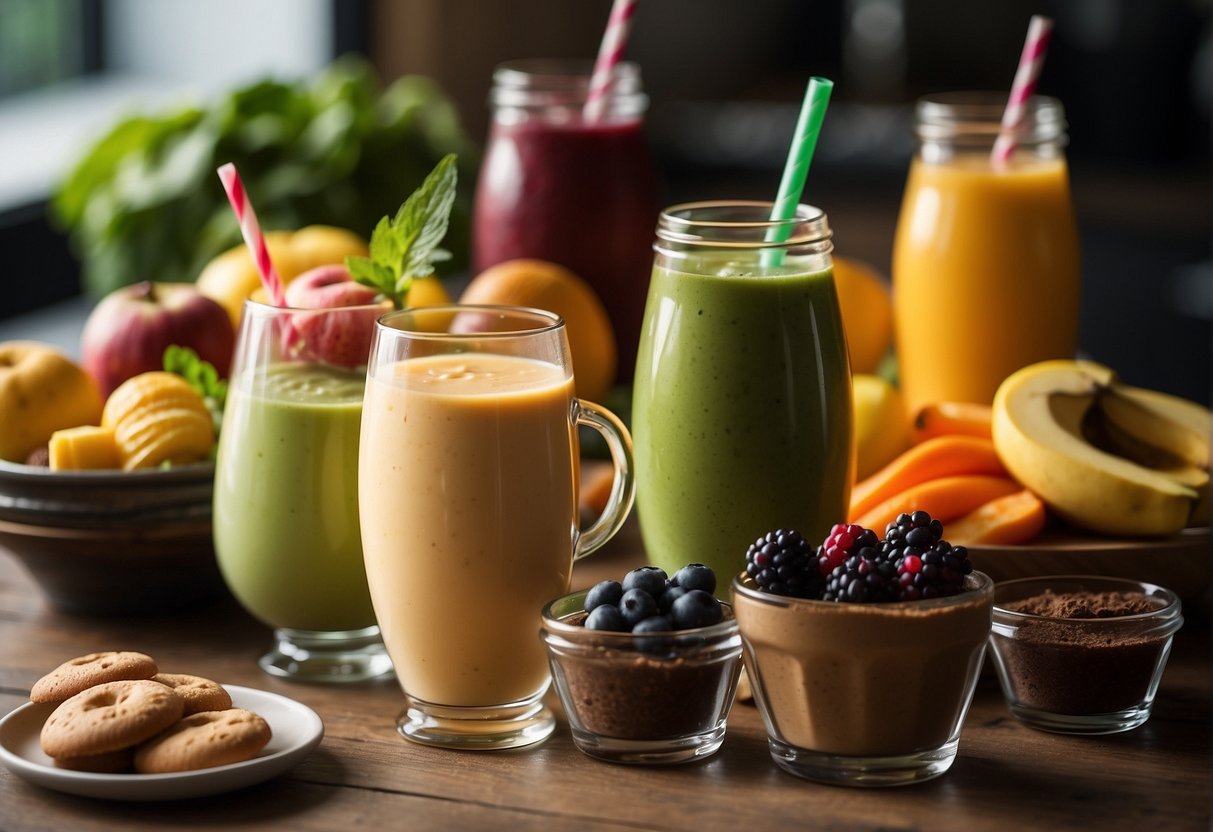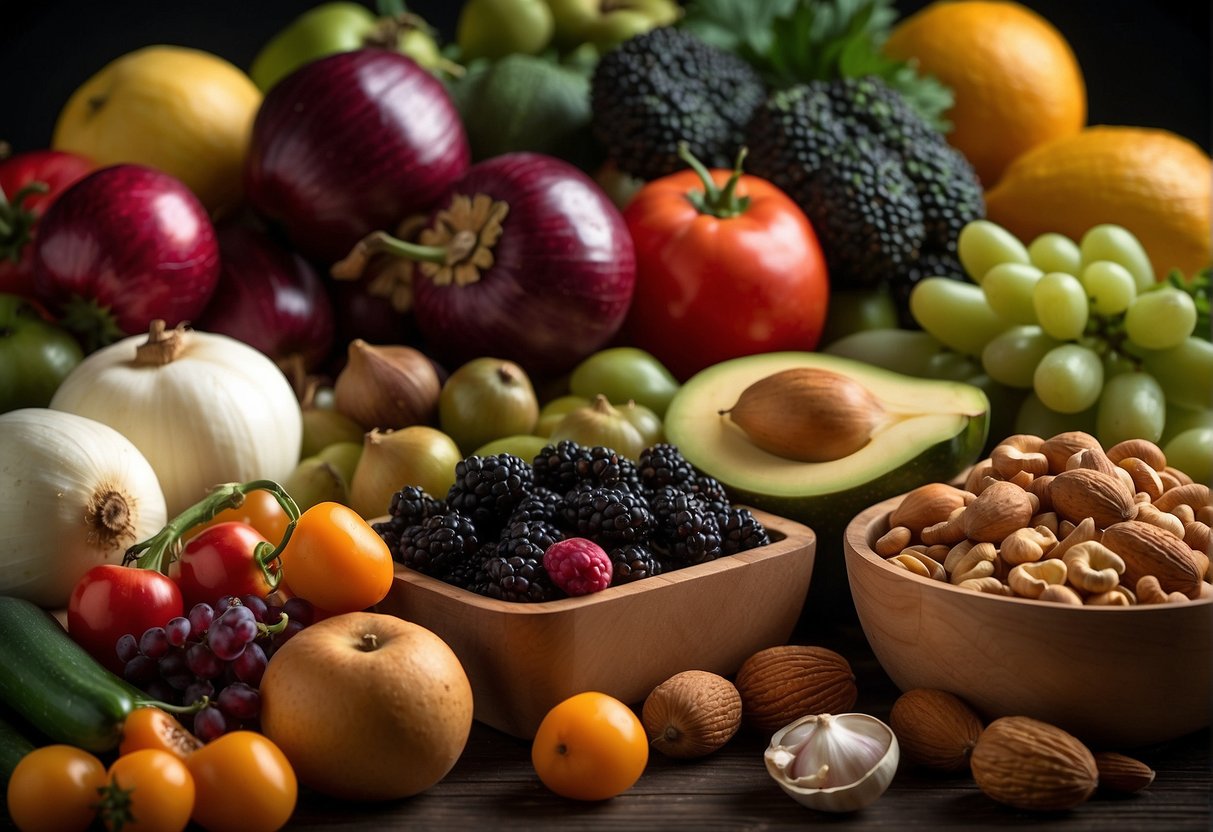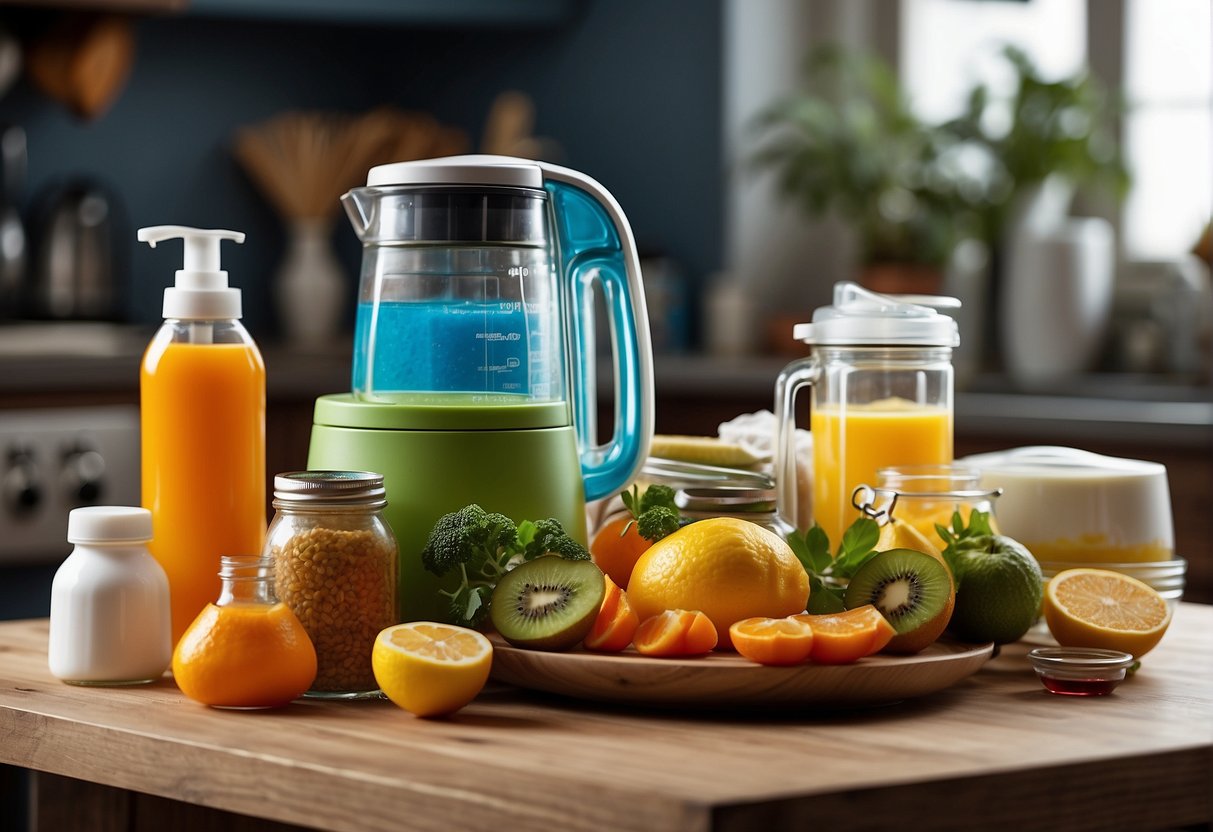Essential Ingredients to Avoid
When I’m whipping up my smoothies, there are a few ingredients I steer clear of to keep things healthy. Here’s my no-go list:
- Alcohol: It may be tempting to add a splash for fun, but it’s empty calories and can dehydrate you.
- Canned fruit: Often packed with syrup and extra sugar, not the best choice.
- Ice cream: It just turns my smoothie into a milkshake in disguise. Way too much fat and sugar.
- Excessive dairy: A little can be okay, but too much dairy ramps up the calories.
| Avoid These Sweeteners | Because… |
|---|---|
| Regular table sugar | It’s just empty calories. |
| High-fructose corn syrup | Same deal, plus it’s bad for my liver. |
| Artificial sweeteners | They can mess with my hunger signals. |
| Excessive honey or maple syrup | Natural, but still high in sugar. |
| Too many dates | They’re healthy, but also sugar dense. |
- Avocado: While it’s got good fats, it’s high in calories, so I use it sparingly.
- Nut butters: They’re packed with protein and fat, great in moderation, but can be calorie-heavy.
Let’s talk about macros for a sec:
- Fiber: Vital for my gut health, but I make sure it comes from whole fruits and veggies.
- Fat: I pick sources like chia seeds instead of saturated fats for heart health.
- Sugar: Natural fruit sugars are my go-to, not added sugars.
- Protein powders: Convenient, but I check for added sugars and artificial ingredients.
By keeping these out of my blender, I ensure my smoothie is a healthy snack, not a sneaky dessert.
Selecting the Right Base
When I’m whipping up a smoothie, choosing the right liquid base is crucial. It sets the stage for flavor, texture, and nutrition. Let’s make sure you’re pouring the best liquid into that blender.
Inappropriate Liquid Choices
Honestly, not all liquids are equal when it comes to smoothies. Stick to my advice and avoid the mistake of reaching for water or fruit juice as a go-to liquid. Water can make your smoothie bland, and typical fruit juices? They’re often loaded with sugar and can spike your blood sugar levels.
Optimal Liquid Alternatives
So, what should you pour in? Almond milk and coconut milk are my favorites. They’re not just tasty; they add a creamy texture without overwhelming the flavor of your fruits and greens. Plus, they’re low in calories and rich in vitamins. If you’re after more probiotics and a tangy kick, kefir or Greek yogurt mixed with a bit of liquid—think nut milks or even plain water—can do wonders.
Impact of Dairy and Lactose
Watch out, dairy can be a frenemy. While milk or Greek yogurt add a punch of protein and a smooth texture, they’re not everyone’s best friend due to lactose. If dairy is not your thing, I suggest turning to lactose-free alternatives like almond milk or other nut milks. They keep it smooth without the stomach gripes, and hey, they toss some healthy fats into the mix, too.
Structuring Nutritional Content

When I create a smoothie, my primary focus is on the nutritional content. It’s essential to construct a drink that’s not only tasty but also beneficial for health goals. Here’s how I like to structure mine:
Avoiding Excess Calories and Fats
I’m conscious about not overdoing it with high-calorie ingredients that can turn my blend from a healthy snack into a calorific trap. For example, although nuts and seeds are packed with good stuff like healthy fats, vitamins, and minerals, they’re also dense in calories and fats. I use them sparingly — a tablespoon is plenty.
- Recommended Add-ins:
- Chia seeds: a source of fiber and healthy fats with fewer calories.
- Almonds: for a dose of vitamins and healthy fats, I limit myself to just a handful.
Controlled Sugar Intake
We all love a bit of sweetness in our smoothies, but I’m careful with my sugar intake. Fruit juice, while seemingly healthy, is a source of added sugars that can spike my blood sugar levels. Instead, I choose whole fruits like berries, which are lower in sugar and high in fiber. For reference, a banana or a handful of strawberries can provide enough natural sweetness without overdoing the sugar.
- Sweetness Swap:
- Dates instead of honey or added sugar for natural sweetness plus a fiber boost.
Incorporating Protein and Fiber
I always aim to make my smoothies both filling and nutritious. Incorporating a good protein source helps me stay full longer and supports muscle health. Protein powder, seeds, or tofu can be great additions. For fiber, nothing beats the benefits of whole fruits and vegetables. My personal favorites are chia seeds for both fiber and protein — they’re tiny but mighty!
- Protein and Fiber Picks:
- Protein powder: for an easy protein boost.
- Spinach or kale: low in calories, full of vitamins, minerals, and antioxidants.
Remember, it’s all about balance and making smart swaps to keep my smoothies as health-promoting as possible.
Choosing Fruits and Vegetables Wisely

When I blend a smoothie, I make sure to pick fruits and veggies that not only taste great together but also offer the right balance of vitamins, minerals, and fiber. It’s about getting both the flavor and the nutrition right.
Fruits to Limit or Include
I tend to be cautious with sweet fruits like bananas, mangoes, and pineapples since they are high in sugar. Even though they make smoothies deliciously sweet and creamy, too much can spike blood sugar levels. Berries such as strawberries, raspberries, and blueberries, on the other hand, are lower in sugar and high in fiber, making them a smart choice for a nutritious blend.
Include More:
- Berries: strawberries, raspberries, blueberries
- Pears
- Peaches
Limit:
- Tropical fruit: bananas, mango, pineapple
- Sweet fruits: overripe bananas
Vegetables That May Not Blend Well
Not all vegetables are smoothie-friendly. Harder veggies like raw carrots or cauliflower may not blend smoothly, while too many leafy greens can create a bitter taste. However, leafy greens like kale and spinach are packed with nutrients and can be balanced with the right fruits. Celery and beets are excellent for their low calorie content and mix well with the right pairings.
Smooth Blenders:
- Avocado: adds creaminess
- Spinach: versatile greens
- Kale: nutritious and blends well when tender
Tricky to Blend:
- Carrots: unless steamed or roasted first
- Cauliflower: can be grainy
- Sweet potatoes: better cooked than raw
Enhancing Flavor and Texture

When I make smoothies, I focus on achieving that perfect balance between rich flavor and pleasing texture. It’s like crafting a symphony where the ingredients are my instruments, each one bringing a unique note to the blend.
Thoughtful Addition of Sweetness
I’m always careful about how I sweeten my smoothies. Natural sweeteners like dates, honey, or maple syrup not only offer a deep, complex sweetness but also provide additional nutrients. I use these sparingly though; often, the sweet fruits themselves are enough. A ripe banana or some berries can do the trick without overloading on extra sugar.
Texture that Complements, Not Distracts
The texture of my smoothies is as important as the taste. I aim for creamy goodness without making it too thick or thin. Avocados and bananas are my go-tos for creaminess, packed with healthy fats that enrich the mouthfeel. A touch of frozen yogurt can also add creaminess, while a handful of seeds or nuts—when blended well—contribute a satisfying body to the drink.
Incorporating Spices and Extras
Lastly, I bring in the aromatic wonders of spices. A dash of cinnamon or a hint of vanilla elevates the flavors. Occasionally, I’ll get adventurous and use a pinch of cardamom for an exotic twist. But I don’t stop there. Sometimes I’ll toss in an extra like cacao powder as suggested by Serious Eats to add depth and interest without overwhelming the core taste of my smoothie.
Safe and Healthy Additions

When I whip up a smoothie, I’m all about tossing in stuff that’s not only tasty but also gives me a solid nutritional bang for my buck. Let’s chat about some go-to ingredients that can amp up that blender game without the side-eye from your nutritionist.
Protein Power-Up: I’m a fan of protein powder because it helps keep me full and fuels my muscles, especially after a workout. Opting for a high-quality, low-sugar option can make a big difference.
Seed Sensation:
- Chia Seeds: Tiny but mighty, these guys are jam-packed with fiber, which means I stay full longer. Plus, they’ve got a nice dose of antioxidants.
- Other Seeds: Flax or hemp seeds are also killer fiber sources and they sneak in some healthy fats too.
Sweetness Without the Guilt: A drizzle of honey can sweeten the deal without the need for refined sugars; it’s natural and a little goes a long way.
Fruit Fiesta: I toss in fresh fruit for natural sweetness and fiber. Berries, bananas, you name it—if it’s fruit, it’s usually in my blend.
Veggie Vibes: Don’t knock it ’til you try it, but spinach or kale can seriously up the vitamin game with minimal flavor change.
Fiber Fix: Fruit skin and veggies bulk up the fiber content, supporting digestion and making each sip count.
Just a Splash: I avoid fruit juice due to the high sugar, opting for water or lemon juice to liquidize and add a zesty twist.
Antioxidant Avenue: Tossing in some blueberries or a dash of turmeric can boost those antioxidant levels big time.
Remember, the key is balance and making sure I enjoy what I’m sipping on. Mixing and matching these ingredients keeps my smoothie life fresh and healthy.
Frequently Asked Questions

I get a lot of questions about what not to mix in smoothies, especially from folks keen on maintaining health or losing weight. So, here’s a nifty FAQ section to address some of these smoothie snafus.
Which fruits are a no-go for smoothies?
Mixing certain fruits can lead to poor flavor or digestive discomfort. For instance, bananas and cranberries may not be the best combo due to contrasting levels of acidity.
Are there any combos to avoid for a health-conscious smoothie?
Yes, indeed. Combining high-sugar fruits with fatty ingredients can spike your calorie count. Also, tossing in too much citrus with dairy can lead to a curdled mess.
Is mixing spinach and fruits in a smoothie a good idea?
Spinach is a green powerhouse and mixing it with the right fruits is awesome for a nutrient boost. However, pairing it with fruits high in oxalates, like blackberries, can reduce calcium absorption.
Why might someone recommend against blending fruits with veggies?
Blending fruits with high-starch vegetables might lead to slower digestion and bloating. It’s typically fine, but if you experience discomfort, you might want to keep fruit and veggie smoothies separate.
What ingredients should I skip if I’m making a smoothie to lose weight?
Focus on low-calorie, high-fiber ingredients. Skip sugary fruits, excessive nut butters, or high-calorie additives like too much protein powder if you’re not balancing it out with your overall diet.
Does adding a banana have any downsides for smoothie flavor or health?
Bananas are a great thickener and add natural sweetness, but they’re high in sugar and calories. If you’re watching your sugar intake, use half a banana or opt for lower-sugar fruits like berries.
